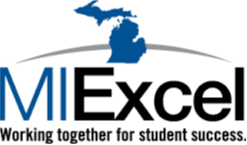Educator Evaluation
We always want to keep life fresh and exciting, and have something to strive for. At Pickford Public Schools, we have been striving for the last year to create a vision and mission statement that will guide all that we do as a district on behalf of the students and families we serve. The Board of Education and district administration sincerely appreciate all of the input that we received from parents and community members through the survey cards, online survey, and focus group meetings held throughout the 2018-19 school year. All of the themes we compiled through this process assisted in the ultimate development of the following statements:
DISTRICT VISION AND MISSION

District Vision Statement
In partnership with families and our community, we prepare our students for their future.
District Mission Statement
Pickford Public Schools is the heart of our community and we build great futures by.
Providing a safe, secure, and inclusive environment where all children can learn.
Being a respected and proven instiller of accountability, respect and honesty for all stakeholders.
Motivating our students, with truth and fairness, to take responsibility for their learning.
Preparing students who communicate effectively, demonstrate self control, think critically, persevere, and adjust to change.
Our Core Values: Accountability, Respect, Honesty
Our Beliefs: All children can learn -- Growth Mindset! Strong relationships are essential.
Our Goals for Students
Apply academic skills
Communicate effectively
Think critically and creatively to solve problems
Use and apply technology
Maintain and enhance physical and emotional health
Work cooperatively with others
Demonstrate self management and practical life skills
Contribute as productive and responsible citizens
Our Goals for the District
1. Create/maintain a safe, welcoming, positive, respectful, and collegial culture that ensures all students learn.
Strategies:
Complete installation of Michigan Integrated Continuous Improvement Process (MCIP) and Whole Child Model (WSCC) to address the non-academic needs of students (tenants include healthy, safe, engaged, challenged, and supported).
Complete planning for building a network of delivery, communication (internally and with external stakeholders), and monitoring to allow staff to effectively and efficiently respond to identified non-academic needs of students along a Multi-tiered System of Support (MTSS).
Deepen knowledge and capacity of Board, Staff, and Community Stakeholders around student support related topics, including Social Emotional Learning, Positive Behavior Intervention Support, Trauma Informed Practices, and the Whole Child Model Pastoral Care.
Intended indicators of success:
End of year Triangle Report in School Wide Information System (SWIS) will show 80% of students at Tier 1 and no more than 10% of students at Tier 3.
Stakeholder surveys will show an annual increase in percent agree with welcoming, positive, respectful, and collegial culture.
SRSS (Student Risk Screening Scale) will show an annual decrease of students identified with internalizing and externalizing behaviors.
Attendance reports will show less than 20% of students as chronically absent (18 days or more) for the school year.
Staff professional learning plans will show evidence of activities and topics related to Social Emotional Learning (SEL), Positive Behavior Intervention Support (PBIS) , Trauma Informed, and Whole Child Model (WSCC).
2. Implement a relevant and rigorous curriculum, aligned to current curriculum frameworks, and delivered using best practice instructional strategies to ensure all students learn.
All students will be on track to be career and college ready in literacy
All students will be on track to be career and college ready in mathematics
All students will be on track to be career and college ready in science
All students will be on track to be career and college ready in social studies
Strategies:
Establish a network of instructional coaching and improvement to support teachers and leaders as they provide instruction and assessment aligned with best practices (Visions of High Quality Instruction & Essential Practices).
Ensure all teachers have access to (or have developed) a guaranteed and viable curriculum for their grade level/content area and developed or adopted an instructional framework that utilizes best practices for their content area.
Increase student proficiency in reading and mathematics at each grade level over the previous year and increase overall district proficiency levels by 3-5% each year.
Support all students in meeting established growth targets in the MAP (Measures of Academic Progress) Benchmark Assessment and Increase student growth rates by 2%ile points for 50-60% of students performing in a below average range of performance (below 41st percentile).
Increase use of technology in the classroom to provide personalized learning opportunities for all students that are based on individual learning goals and competencies.
Intended Indicators of Success:
PLC (Professional Learning Community) Feedback and VHQI (Vision of High Quality Instruction) Walkthrough data demonstrates focus on high quality instructional practices (teacher and student actions) 75% or more of the time.
Staff use of available coaching supports to complete coaching cycles (K-12 math and K-3 literacy) will be documented by records from coaching cycles showing teacher participation.
Class report from MAP assessment (year-end) demonstrates 80% of students scoring in the average range or higher for grade level.
Quadrant report from MAP assessment (year end) demonstrates 80% of students achieving average to above average growth.
M-Step results will demonstrate average to above average growth by cohort as per Student Growth Percentile score.
Increase opportunities for students to participate in online instruction through the EUP Virtual Collaborative.
Investigate and adopt a literacy instructional framework for K-5 aligned with the Essential Practices.
3. Implement a process to ensure involvement and participation of all stakeholders in the learning process.
Strategies:
Provide students and families with choices and meaningful opportunities to improve their school experience (ie. Student Support Services, Academic Intervention and Enrichment, Elective Course Options, Post Secondary Options, Student Organization Memberships).
Leverage community assets and resources to provide full-service support to families; ensure that the school is the center of community learning through programming and partnerships with other community organizations
Develop (or utilize current) district communication systems to showcase student achievement and system improvement work throughout the district.
Intended Indicators of Success:
Publicly report on established district goals (website, data results summary).
Increased use of stakeholder survey opportunities to collect perception data.
Completed system for logging connections to external community supports and available monthly reports to the Board.
Increased promotion of district through print and digital media to include quarterly newsletters, BOE Committee reports/minutes, and social media platforms, and district representation on local boards and at community events.
Increased attendance of Board members and District Administration at community meetings and events as per calendar sign up and monthly BOE reports.
Publicly recognize/spotlight students, staff, administrators, and board members for outstanding effort and/or achievement.
Maintain a virtual participation option for the public in Board of Education meetings that allows a distant audience to watch and listen to the meeting.
Development and distribution of “One pager” District Communication Plan document.
4. Create/Maintain a financially stable, operationally efficient organization.
Strategies:
Maintain 10-15% fund equity
Prioritize applications for grant writing and funding
Take advantage of opportunities to consolidate services and streamline operations based upon providing positive impact on student learning
Maintain district facilities at a high level and continually explore opportunities to enhance facilities to meet the evolving needs of our student population
Intended Indicators of Success:
Schedule of monthly Finance Committee meetings available, including minutes from the committee meeting that are communicated to the full Board. Minutes will show routine discussion and review of financial trends with administration that help to identify and quantify opportunities, risks, and goals with strategies developed.
BOE members take advantage of available opportunities for professional learning on school finance topics.
Schedule of Building and Grounds Committee meetings available, including minutes from the committee that are communicated to the full Board. Minutes will show identification of projects and sourcing of resources and revenue aimed at continually increasing the utility, functionality, and attractiveness of district buildings and grounds.
Complete building project within budget and on (revised) schedule with minimal bid alternates. Provide showcasing opportunities throughout to update the community on progress.
5. Develop collective capacity and knowledge of the board of education.
Strategies:
Develop and implement an annual plan of professional development for all board members
Adopt a annual district plan that includes vision statement, mission, and goals with specific performance indicators
Conduct a yearly self-evaluation to evaluate board performance with results to inform goal setting
Review Board Governance Standards on an annual basis and conduct self-reflection of performance against the standards
Provide opportunity for stakeholder involvement through student, staff, and community group/organization presentations to the Board
Intended Indicators of Success:
Existence of Professional Development record for the full Board and for individual BOE members along with transcripts of certifications earned via completion of CBA courses..
Evidence of annual MASB Self-Assessment Survey completion, reflection on MASB Board Governance Standards, and development of District Goals.
Record of presentations to the Board by student, staff, and community groups.
Evidence of BOE Member and Superintendent Participation in County, Regional, and Statewide meetings/organizations (virtually wherever possible) to provide updated information on funding, legislation, and best practices through monthly superintendent reports and updates.

